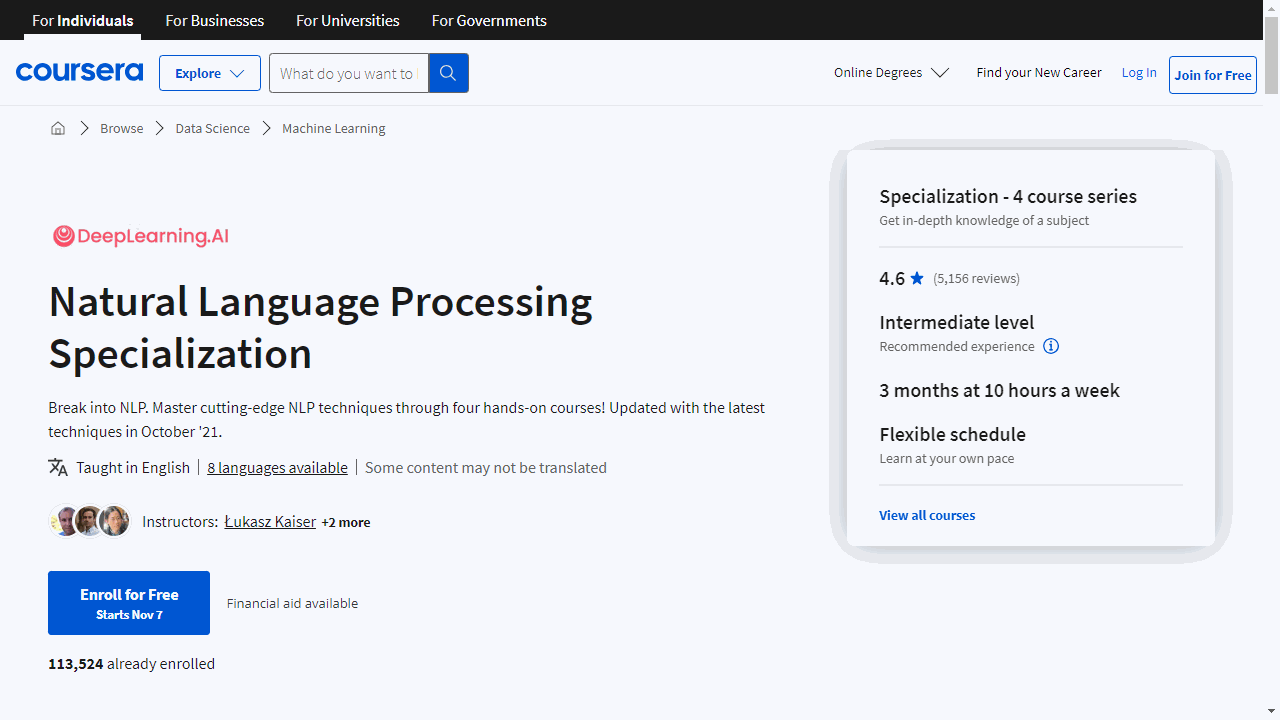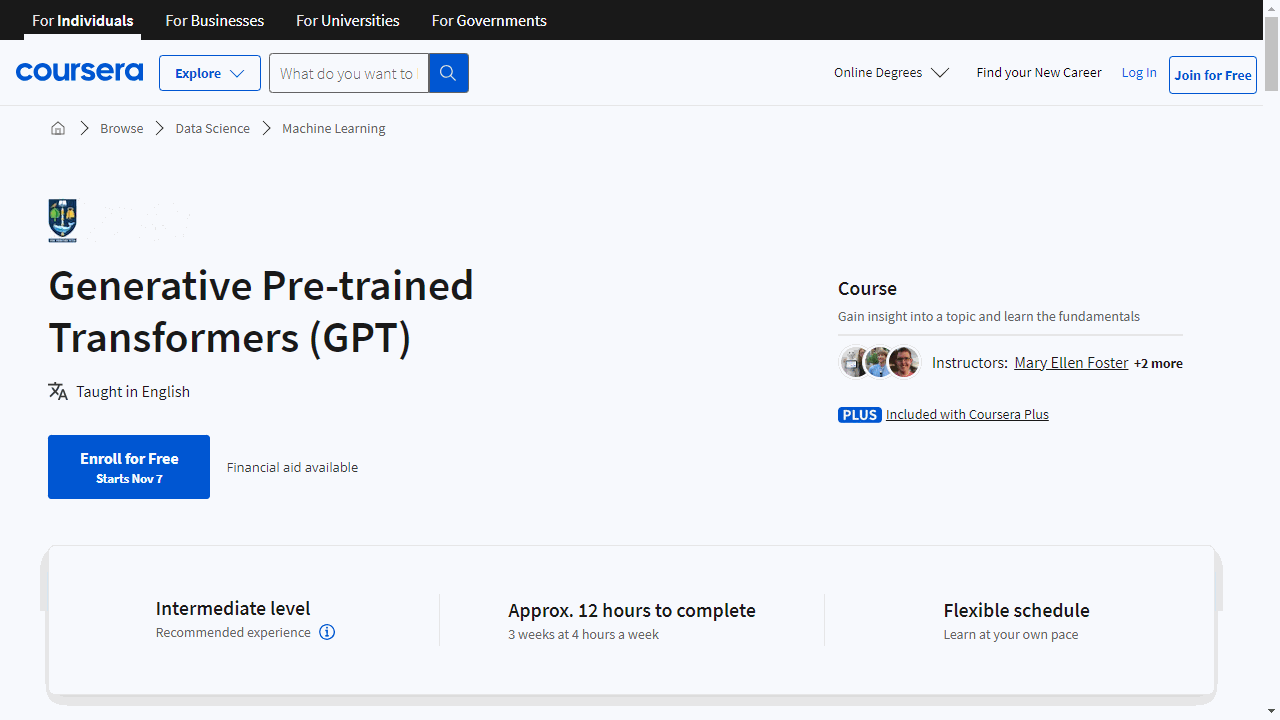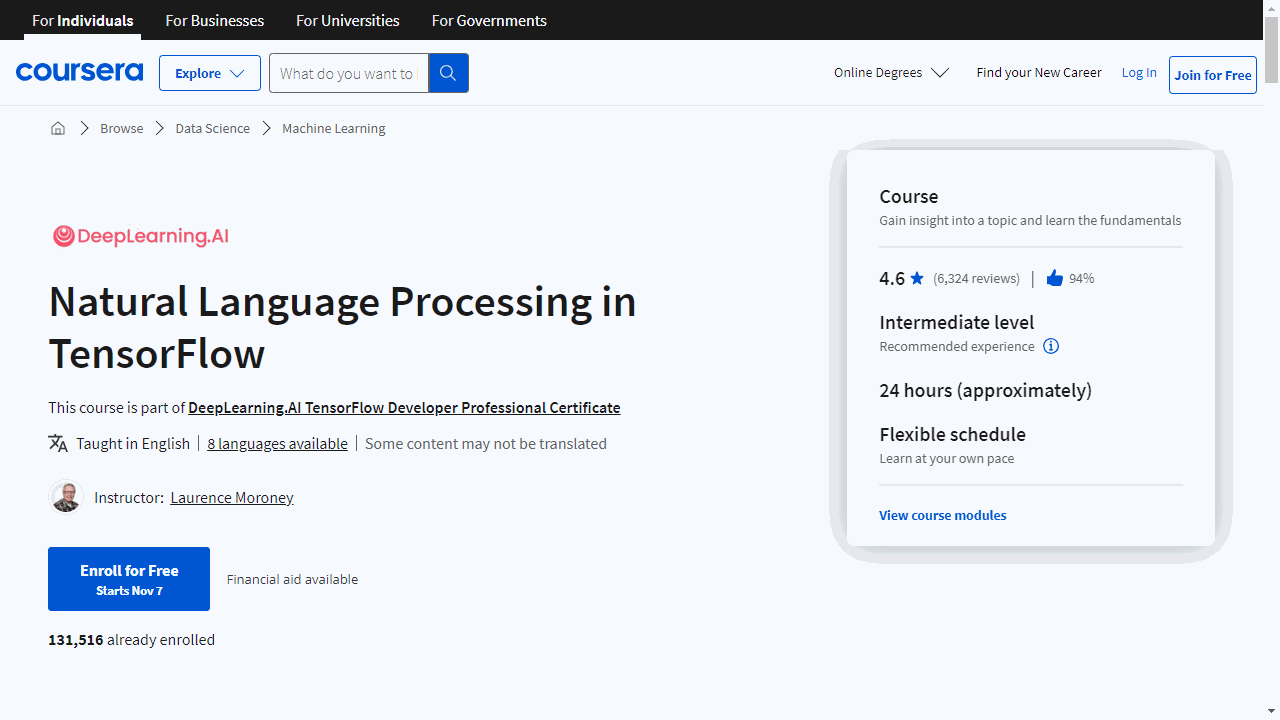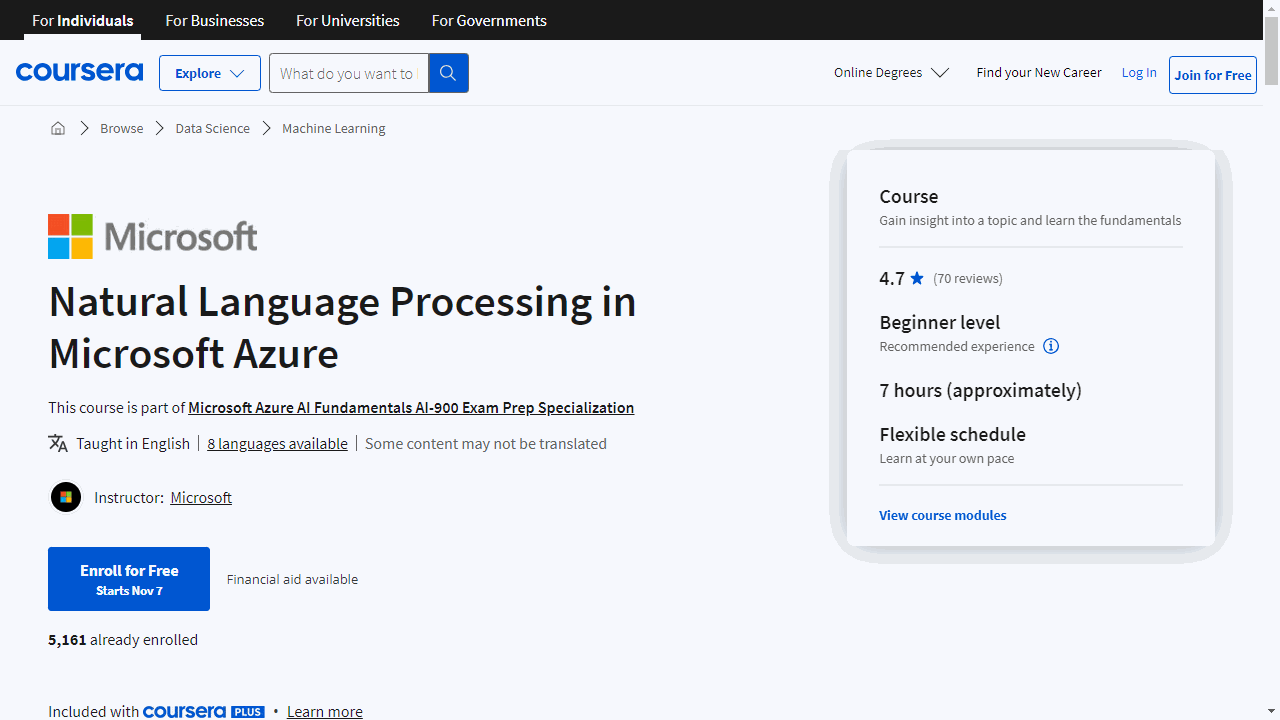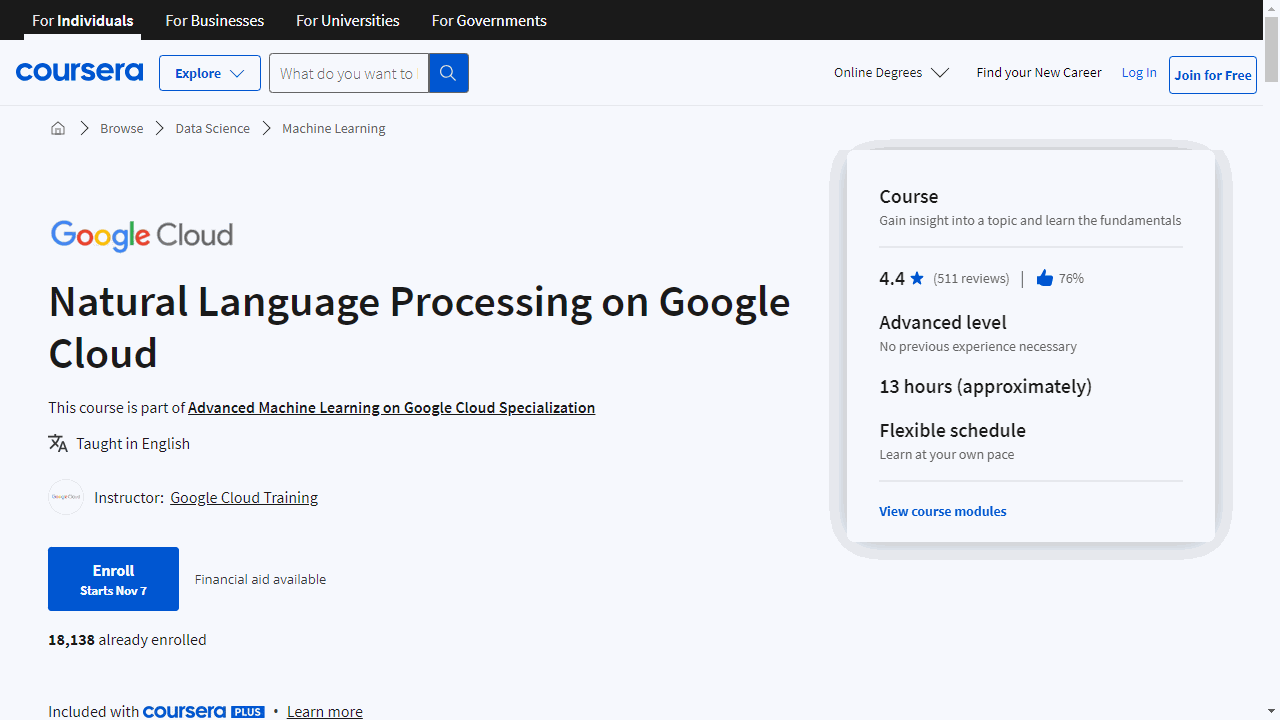Finding a great Natural Language Processing course can be a real struggle, especially on a platform like Coursera where there are so many options to choose from.
You want a course that is thorough, engaging, and taught by experts, but it should also fit your learning style and goals.
We’ve carefully reviewed the best NLP courses on Coursera and picked out our top recommendations to help you make the right choice.
For the best NLP course overall, we recommend the Natural Language Processing Specialization by DeepLearning.AI.
This series is a goldmine for anyone looking to master the art of teaching computers to understand human language.
From sentiment analysis to question answering, this specialization covers a wide range of NLP topics, diving deep into foundational concepts and practical applications, all while providing engaging projects and real-world examples.
But this is just the start of our recommendations.
We’ve got courses for beginners, intermediate learners, and experts, as well as options focused on specific NLP tools and applications.
Keep reading to find the perfect course for your needs.
Best Natural Language Processing Courses On Coursera In 2024
Natural Language Processing Specialization By DeepLearning.AI
This series is a goldmine for anyone eager to master the art of teaching computers to understand human language. Let’s dive into what makes each course stand out and why they’re worth your time.
Start your journey with “Natural Language Processing with Classification and Vector Spaces.”
Here, you’ll unlock the secrets of sentiment analysis, learning to gauge the emotions behind tweets with logistic regression and naïve Bayes.
You’ll also explore the connections between words using vector space models and even dip your toes into machine translation, crafting a simple English to French translator.
This course sets the stage for you to create applications that can analyze text and answer questions with precision.
Then, there’s “Natural Language Processing with Probabilistic Models.”
Ever been saved by auto-correct when texting? You’ll get to build one yourself, understanding the magic behind those helpful suggestions.
You’ll also tackle part-of-speech tagging with the Viterbi Algorithm, a cornerstone of computational linguistics. And for a cherry on top, you’ll construct a Word2Vec model, teaching a neural network to understand word meanings through embeddings.
As you progress to “Natural Language Processing with Sequence Models,” things get even more exciting.
Now you will train neural networks to perform sentiment analysis on tweets, and generate text.
You’ll also learn named entity recognition to extract key information from sentences. Plus, you’ll experiment with ‘Siamese’ network models to identify questions with the same intent but different wording.
Cap off your learning with “Natural Language Processing with Attention Models.”
Here, you’ll translate full sentences into German and summarize blocks of text using cutting-edge attention models.
You’ll also get hands-on with T5 and BERT, the powerhouses of NLP, for question-answering tasks. And if you’ve ever dreamed of creating a chatbot, this course will show you how, using a Reformer model.
The brains behind this Specialization are Younes Bensouda Mourri from Stanford, Łukasz Kaiser from Google Brain.
With a bit of machine learning and Python knowledge in your toolkit, you’re all set to embark on an NLP adventure that could transform your career in data science.
Generative AI with Large Language Models
This course offers a comprehensive journey through the landscape of Generative AI, providing a blend of foundational knowledge and practical application.
The course begins with an accessible introduction to Generative AI and Large Language Models (LLMs), setting the stage for what’s to come.
You’ll explore the evolution of text generation, moving from pre-transformer techniques to the cutting-edge transformer architecture that’s reshaping how machines understand and produce language.
What sets this course apart is its focus on the practical side of AI. You’ll learn the art of prompt engineering—how to effectively communicate with AI to elicit the best responses.
The course also walks you through the entire Generative AI project lifecycle, giving you a holistic view of the process from conception to completion.
Through AWS labs, you’ll confront the challenges of training LLMs firsthand. For those interested in the technical aspects, there’s additional content on optimizing multi-GPU strategies for more efficient computing.
As you progress to Week 2, the course delves into the nuances of model fine-tuning.
You’ll discover how to tailor models to specific tasks, and you’ll be introduced to PEFT techniques such as LoRA and Soft prompts. These techniques make it possible to fine-tune models much faster and with minimal data.
The third week addresses the ethical dimension of AI. You’ll engage with the concept of RLHF, learning how to align AI behavior with human values—a critical skill in today’s tech landscape.
For those with a keen interest in the mechanics of AI, there’s an optional deep dive into Proximal Policy Optimization.
Beyond building models, the course equips you with the knowledge to integrate LLMs into real-world applications.
You’ll explore how to enhance AI reasoning and planning capabilities, and you’ll gain insights into advanced concepts like program-aided language models.
The course concludes with a thoughtful discussion on Responsible AI, ensuring that you’re not only technically proficient but also ethically aware.
Generative Pre-trained Transformers (GPT)
The course begins by laying a solid foundation, explaining what language models are and why they’re important.
You’ll quickly move from theory to practice, exploring N-gram language models, which are crucial for understanding how machines process language.
As you progress, you’ll delve into the art of text generation.
This isn’t just about programming a machine to write sentences; it’s about understanding the nuances that allow AI to produce coherent and contextually relevant text.
The core of the course focuses on the Transformer architecture, the powerhouse behind the most sophisticated language models. You’ll gain insights into how these models are trained,.
You’ll also get hands-on experience with GPT and BERT, two of the most advanced models in NLP. Learning to use GPT will become a key skill in your repertoire, enabling you to leverage its capabilities for various applications.
However, the course doesn’t shy away from the complexities and responsibilities that come with powerful technology.
You’ll engage with the ethical challenges posed by large language models, ensuring that you’re not just technically proficient but also ethically informed.
As you approach the end of the course, you’ll examine the phenomenon of hallucinations in language models, understand the intricacies of chatbots, and discuss the implications of ChatGPT.
The course also covers important topics like academic conduct, creativity, copyright, and the broader regulatory and risk landscape of NLP.
By the time you complete the course, you’ll have a well-rounded understanding of Generative Pre-trained Transformers, ready to apply this knowledge practically and responsibly.
Whether you’re aiming to advance your career or simply have a passion for AI, this course provides the tools and insights you need to navigate the exciting world of NLP with confidence.
Natural Language Processing in TensorFlow
If you’re searching for a comprehensive course in Natural Language Processing that leverages TensorFlow, this is a solid choice.
This course is designed to provide a thorough understanding of NLP, and it’s structured to ensure you gain practical experience along with theoretical knowledge.
You’ll start with the essentials, learning about word-based encodings and how to interact with APIs.
The course emphasizes hands-on learning, and you’ll quickly move on to exercises where you convert text into sequences—a fundamental skill in NLP.
Tokenization and padding are introduced early on, equipping you with the tools necessary for preparing data for deep learning models.
The curriculum includes an intriguing lesson on sarcasm detection, which is not only engaging but also showcases the subtleties and complexities of human language.
As you progress, the course delves into the IMDB dataset, guiding you through the process of vectorizing text and constructing a classifier. The lessons are structured to break down the code into manageable segments, ensuring that you understand each part before moving on.
The course also covers advanced topics such as Long Short-Term Memory networks (LSTMs) and their implementation.
Although Transformers are dominating the scene, this is crucial for anyone looking to work with sequential data in NLP.
Additionally, you’ll explore the application of convolutional networks to text data, revisiting the IMDB dataset with these new techniques.
One of the highlights of the course is the project on predicting the next word in a sentence, which not only consolidates your learning but also demonstrates a practical application of NLP.
The course even ventures into creative applications, like generating poetry, showcasing the versatility of the skills you’re acquiring.
Each lesson is accompanied by a notebook, allowing you to code and see immediate results. This interactive approach is effective for reinforcing the material and building your confidence as you work through the course.
Natural Language Processing in Microsoft Azure
If you company or project is using Microsoft Azure, this course is a great choice for learning NLP.
The course begins with an introduction to NLP, setting a strong foundation by explaining its significance in technology today. You’ll gain a clear understanding of how NLP functions and its applications.
Moving on, you’ll delve into Text Analytics using Azure. This section demystifies how machines interpret human language, a critical skill for managing and extracting insights from large volumes of data.
Speech recognition and synthesis are up next. Azure’s Speech services will be your tools for teaching computers to understand spoken words and respond audibly.
Weekly summaries serve as checkpoints, ensuring you’ve fully grasped the material before proceeding. It’s a thoughtful feature that reinforces learning and keeps you on pace.
The course also covers translation, both literal and semantic, using Azure’s Translation services. You’ll learn to create solutions that can seamlessly translate languages, a valuable asset in our globalized world.
Language Understanding is another key component. You’ll get practical experience with building applications that not only hear but comprehend and act on spoken commands.
Finally, you’ll explore Conversational AI, where you’ll learn to construct chatbots using QnA Maker and Azure Bot Service. This skill is increasingly sought after as businesses look to automate and enhance customer interactions.
Natural Language Processing on Google Cloud
This course is designed to equip you with a thorough understanding of NLP, combining foundational knowledge with practical application on one of the most powerful cloud platforms available.
The course begins with an introduction to NLP, where you’ll learn about its history and architecture.
This sets the stage for exploring the various NLP APIs and solutions that Google Cloud offers. It’s not just about learning the concepts; you’ll also see them in action.
One of the key features of this course is its hands-on approach.
Early on, you’ll get acquainted with Google Cloud Platform and Qwiklabs, which will be your playground for experimenting with technologies like the Dialogflow API.
This lab allows you to experience firsthand how NLP can be used to create conversational agents.
As you progress, the course introduces you to the breadth of NLP tools within Google Cloud, including Vertex AI and AutoML.
You’ll learn how to train models with ease and even delve into custom model training.
The Text Classification with AutoML lab is particularly insightful, offering a practical example of how to apply your new knowledge.
The technical aspects of NLP are made accessible as well.
You’ll explore tokenization, one-hot encoding, and word embeddings, including Word2vec.
The course demystifies these concepts and reinforces your learning with a lab on reusable embeddings, showcasing how these techniques are applied in real-world scenarios.
For those interested in the inner workings of machine learning, the course covers various neural network architectures, such as DNNs, RNNs, LSTMs, and GRUs.
You’ll also get to grips with TensorFlow and Keras through a lab focused on text classification, providing a clear understanding of how these tools are used in NLP tasks.
The course doesn’t shy away from cutting-edge topics either. You’ll dive into the encoder-decoder architecture, attention mechanisms, transformers, BERT, and large language models.
The lab on text translation using encoder-decoder architecture is particularly valuable, giving you a glimpse into the future of NLP.
By the end of the course, you’ll have a comprehensive view of NLP and practical experience with Google Cloud’s NLP tools.
JSON and Natural Language Processing in PostgreSQL
A very important part of NLP that is not covered in the other courses is how to store and query text data. This is addressed in this course.
The course begins by grounding you in the essentials of PostgreSQL, such as how rows are allocated to blocks. This foundational knowledge is crucial for understanding database performance and is presented in a clear, understandable way.
You’ll then move on to the construction of inverted indexes using SQL. The course includes demonstrations that show you the process step by step, demystifying the complexities of database searches.
One of the highlights of this course is the section on building a natural language index with SQL. Through practical demonstrations, you’ll learn how to create systems that can understand and organize human language—a skill at the forefront of database technology.
As you progress, you’ll delve into GIN-based inverted indexes and discover how to implement full-text search capabilities within PostgreSQL. The demonstrations are particularly helpful, offering you a chance to see these concepts in action.
Python integration is another critical aspect of this course. Through lectures and demonstrations, you’ll learn how to harness the power of Python to extend the functionality of PostgreSQL, merging database management with one of the most popular programming languages.
The course doesn’t shy away from the importance of JSON in today’s data-driven world. An interview with Douglas Crockford offers insights into JSON’s significance, and subsequent lectures explore how to manipulate JSON data within Python and PostgreSQL.
Practical applications are a strong focus in the latter part of the course. You’ll work with JSON APIs and manage data sets, such as music tracks, enhancing your hands-on experience. The Star Wars API demonstration, for example, is not only engaging but also illustrates real-world JSON usage.

